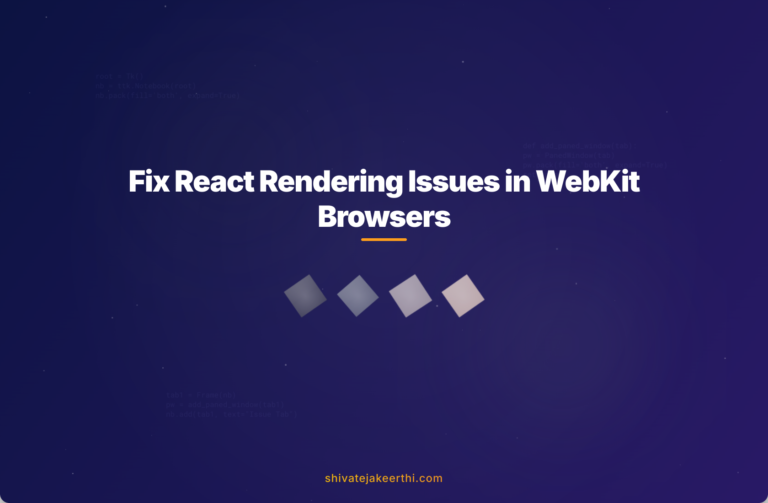If you’ve ever encountered a situation where your React application runs perfectly in Chrome, Firefox, or Edge but simply refuses to render in WebKit-based browsers like Safari, you’re not alone. Bundled React apps not rendering specifically in WebKit-based browsers is surprisingly common and quite frustrating—especially when everything seems fine on the development end.
Let’s break down this issue step by step and discuss a few strategies to solve this tricky problem.
Problem: React App Not Rendering in WebKit-Based Browsers
One of the main headaches that React developers sometimes experience occurs when their bundled applications unexpectedly fail to load or render correctly in WebKit browsers. WebKit fully powers browsers like Safari and many embedded browser environments, meaning your app might break not only on desktop Safari, but also on iOS devices and unique browser implementations.
The main symptom? Your React application may show a completely blank screen or simply not load fully, even though the JavaScript bundle was built successfully and works great on most other browsers.
Typically, this issue surfaces in environments with slightly outdated WebKit engine versions, such as embedded web views used within custom web-based applications, older Safari versions, or constrained environments like Smart TVs.
What Doesn’t Work: Debugging Challenges and Lack of Errors
Debugging this rendering issue poses significant difficulty. Usually, you’d turn to your browser’s developer tools console to get valuable hints. Unfortunately, in this case, WebKit often gives little-to-no explicit error message.
Common frustrations include:
- No visible console errors: WebKit might produce zero console warnings or error logs, making it tough to pinpoint the problem.
- No DOM elements rendered: The bundle loads but doesn’t produce the expected React DOM elements.
- Hard-to-isolate issues: Your development environment works perfectly, giving a false sense of correctness during development.
Key Findings: Modern JavaScript Compatibility in WebKit
One major finding is that WebKit-based browsers—especially older versions or embedded implementations—often lag behind in implementing newer JavaScript features fully.
For instance, modern JavaScript syntax introduced via ES6 and later standards might not work smoothly with these environments. Even though modern browsers and Node-based setups easily handle advanced syntax with the help of Babel, bundlers like webpack, Vite, or Parcel may still create code that’s subtly incompatible with WebKit browsers.
You might see issues like:
- Problems with JavaScript modules (import/export) handling
- Advanced destructuring or spread operators not executed correctly
- JSX transpilation challenges causing rendering issues
Interestingly, loading React via CDN (like unpkg.com) directly using React’s old-style React.createElement() syntax rather than modern JSX often solves these issues altogether.
Comparative testing shows:
- Bundled React app: Blank screen or incomplete rendering in WebKit.
- CDN-loaded React without JSX: Functional, stable rendering of the React components.
- JSX vs Vanilla JavaScript syntax: WebKit’s JavaScript engine sometimes struggles with JSX code complexity, preferring plain JavaScript.
In other words, WebKit’s limitation revolves around incompatibility related primarily to how modern JavaScript aspects are transpiled or bundled.
Current Workaround: Loading React via CDN and Avoiding JSX
Faced with immediate production pressure, a practical workaround is loading React as plain scripts rather than through a modern JavaScript bundle. By using CDN-hosted scripts (for instance, from unpkg.com/react and unpkg.com/react-dom), you bypass modern bundler intricacies.
Here’s a simplified example of using React directly from CDN without JSX:
<script src="https://unpkg.com/react@17/umd/react.production.min.js"></script>
<script src="https://unpkg.com/react-dom@17/umd/react-dom.production.min.js"></script>
<div id="root"></div>
<script>
ReactDOM.render(
React.createElement("h1", null, "Hello WebKit"),
document.getElementById("root")
);
</script>
With a setup similar to the above:
- No JSX transpilation needed (thus directly avoiding bundling-related JS issues).
- Directly supported older JavaScript environments because it’s plain JavaScript.
- Immediate enhanced reliability on WebKit browsers.
Although it resolves the rendering issue, the trade-off is clear: you lose modern workflow conveniences such as JSX syntax, modular component architecture via bundlers, TypeScript, and a rich ecosystem of plugins and features provided by bundlers such as webpack or Vite.
The current development environment setup, to clarify, is typically:
- Browser: WebKit-based browsers (Safari engine, popular in embedded tools, iOS WebViews, older devices)
- Bundler Tools: webpack, Parcel, or Vite (standard modern bundlers)
- Framework: React using modern JSX syntax, transpiled usually via Babel
Seeking a Better Solution: Modifying the Bundling Process for WebKit Compatibility
Still, CDN-based React implementation is unsatisfactory because modern React development significantly benefits from JSX, modern JavaScript syntax, and module bundling features. This leads us to ask an important question:
What exactly causes the bundled React build failure in WebKit-based browsers?
One strong suspicion relates to browser target compatibility settings in bundlers like webpack and tools like Babel Preset Env. It’s possible these tools are outputting JavaScript code incompatible with the specific WebKit JavaScript runtime.
Specifically, you can adjust your bundler to target specific browser compatibility explicitly:
- In webpack, leverage the
browserslistfield in yourpackage.jsonor.browserslistrc. - In Babel, explicitly define the supported browser targets to ensure better compatibility.
- Use polyfills for missing or unsupported features in your WebKit-based runtime.
Example of a browserslist configuration (in package.json):
{
"browserslist": [
"> 0.5%",
"last 2 Safari major versions",
"iOS >= 11",
"not dead"
]
}
Furthermore, explicit polyfill inclusion for advanced JavaScript features might resolve compatibility issues:
- Add polyfills such as core-js and configure correctly in bundlers.
- Use Babel Polyfill, correctly set up in your build chain.
Before adopting these adjustments, measure browser support carefully and ensure you target specific versions of WebKit browsers causing trouble.
Looking Forward: Inviting Reader Engagement
Have you experienced similar problems running bundled React applications specifically in WebKit environments? If so, have you found solutions beyond CDN workarounds?
If you have insights regarding advanced bundling settings, polyfill techniques, or unique debugging approaches tackling these WebKit compatibility hurdles, share your thoughts, links, or experiences in the comments.
Together, we can demystify what specifically causes these rendering issues and create smoother, universally compatible React experiences—no matter the browser engine.
For further insights on modern JavaScript techniques or React best practices, visit our extensive collection of JavaScript articles.



0 Comments